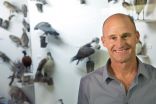(Press-News.org) FORT LAUDERDALE-DAVIE, Fla. - We all know that ducks, crows, falcons and egrets are birds. A group of scientists, however, wanted to dig deeper and unlock more about how these animals are related genetically. The idea was to investigate how modern species of birds emerged and evolved after the dinosaurs disappeared from the earth. This research included work from Stephen O'Brien, Ph.D., a professor at NSU's Oceanographic Center whose main focus in genomics.
Now findings from this research are being announced in several scientific publications, including Science magazine, Genome Biology and GIGA Science.
For the past four years, O'Brien has been part of an international consortium of scientists working to detail the genome sequence of 48 different birds. This group of researchers - who call themselves the Avian Phylogenomics Group - is made up of 200 scientists from 80 institutions in 20 countries. This group is an "outgrowth" of the Genome 10K Project (G10K,) which was co-founded in 2009 and led by O'Brien.
"The Avian Phylogenomics Studies have become a 'fait accompli,' raising the standards of comparative genome bioinformatics to a higher standard than ever before," O'Brien said. "We at NSU's Oceanographic Center are grateful to the international consortium for the opportunity to contribute in making all this happen."
Prior to his role with NSU, O'Brien served as Chief of the Laboratory of Genomic Diversity at the National Cancer Institute (NCI,) National Institutes of Health (NIH.) for 25 years. In 2011 he joined the Theodosius Dobzhansky Center for Genome Bioinformatics, St. Petersburg State University (Russia) as its Chief Scientific Officer. He also serves as Director of Research for NSU's Office of Research and Technology Transfer.
O'Brien is well known for his research contributions in comparative genomics, virology, genetic epidemiology, mammalian systematics and species conservation. In 1983, he and his collaborators discovered the remarkable genetic uniformity of the African cheetah, a prelude to a new discipline of Conservation Genetics.
With more than three decades of field studies with his students and colleagues, O'Brien subsequently reported in approximately 300 publications, many in the highest rated scientific journals of how genetics could inform and facilitate management action for endangered species. These included identifying new species of elephant, clouded leopard and orangutan plus detailed genetics studies on threatened wildlife species including cheetahs, lions, tigers, giant panda, leopards, pumas, jaguars, koalas, humpback whales and our Florida panther.
The group saw several advantages to studying the bird genome. Birds have remarkable adaptive diversity (from flight/feathers to song/speech to dazzling plumage coloration to teeth loss.) Also, whereas most vertebrate genomes typically carry 50 percent repeated sequence, birds have around 5-10 percent repeats, which translates into a considerably smaller genome size. The various species selected were chosen as they comprise approximately 95 percent of the living bird species on earth. Some of what the Avian Phylogenomics Group found included, but was not limited to:
A precision evolutionary tree connecting modern bird as their ancestors split into modern families and genera;
Specific new candidate gene associations with vocal learning as well as for skeletal development to be light and aerodynamic;
Gene losses in bioenergetics genes, hypothesized to allow for more efficient oxygen metabolism for flight; and
Rapid evolution of 15 pigmentation genes associated with plumage for mating display.
INFORMATION:
About Nova Southeastern University
Situated on 314 beautiful acres in Ft. Lauderdale, Florida, Nova Southeastern University (NSU) is a dynamic research institution dedicated to providing high-quality educational programs at all levels. NSU is an independent, not-for-profit institution with approximately 26,000 students at campuses in Fort Lauderdale, Fort Myers, Jacksonville, Miami, Orlando, Palm Beach and Tampa, Florida as well as San Juan, Puerto Rico. NSU awards associate's, bachelor's, master's, specialist, doctoral and first-professional degrees in a wide range of fields. NSU is classified as a research university with "high research activity" by the Carnegie Foundation for the Advancement of Teaching, and it is one of only 37 universities nationwide to also be awarded Carnegie's Community Engagement Classification. For more information, please visit http://www.nova.edu. Celebrating 50 years of academic excellence!
About NSU's Oceanographic Center
NSU's Oceanographic Center provides high-quality graduate education programs (i.e. master"s, doctoral, certificate) in a broad range of marine science disciplines. Center researchers carry out innovative, basic and applied marine and research programs in coral reel biology, ecology, and geology; fish biology, ecology, and conservation; shark and billfish ecology; fisheries science; deep sea organismal biology and ecology; invertebrate and vertebrate genomics, genetics, molecular ecology, and evolution; microbiology; biodiversity; observation and modeling of large scale ocean circulation, coastal dynamics, and ocean atmosphere coupling; benthic habitat mapping; biodiversity; histology; and calcification. For more information, please visit http://www.nova.edu/ocean
A Texas Tech University biologist led a team of more than 50 scientists who mapped the genomes of three crocodilians.
By mapping these genomes, scientists may better understand the evolution of birds, which are the toothy predators' closest living relatives, said David Ray, an associate professor of biology. The team completed genomes of a crocodile, an alligator and a true gharial to complete the genomic family portrait.
Their research, largely funded by the National Science Foundation, will appear Friday (Dec. 12) in the peer-reviewed journal, Science.
"One of the ...
Scientists from Nanyang Technological University (NTU) have discovered exactly how the malaria parasite is developing resistance towards the most important front-line drugs used to treat the disease.
Malaria is a mosquito-borne parasite which affects over 60 million people worldwide and in serious cases, can be fatal. There is currently no viable vaccine for malaria while antimalarial drugs and prophylaxis are losing its efficacy with increasing drug resistance.
NTU Associate Professor Zbynek Bozdech, who led an international research team from 11 different countries, ...
The first findings of the Avian Phylogenomics Consortium are being reported nearly simultaneously in 28 papers -- eight papers in a Dec. 12 special issue of Science and 20 more in Genome Biology, GigaScience and other journals. The full set of papers in Science and other journals can be accessed at avian.genomics.cn
Scientists already knew that the birds who survived the mass extinction experienced a rapid burst of evolution. But the family tree of modern birds has confused biologists for centuries and the molecular details of how birds arrived at the spectacular biodiversity ...
New research from the University of Kent suggests that chickens and turkeys have experienced fewer gross genomic changes than other birds as they evolved from their dinosaur ancestor.
Professor Darren Griffin and a team at the University's School of Biosciences have conducted research that suggests that chromosomes of the chicken and turkey lineage have undergone the fewest number of changes compared to their ancient avian ancestor, thought to be a feathered dinosaur.
The Kent research is part of a study by a consortium of leading scientists into avian or bird genomes, ...
An international team of scientists has completed the largest whole genome study of a single class of animals to date. To map the tree of life for birds, the team sequenced, assembled and compared full genomes of 48 bird species representing all major branches of modern birds including ostrich, hummingbird, crow, duck, falcon, parrot, crane, ibis, woodpecker and eagle species. The researchers have been working on this ambitious genetic tree of life, or phylogeny, project for four years.
As part of the Avian Phylogenomics Consortium -- comprised of more than 200 scientists ...
NEW YORK, NY (December 11, 2014) Growing resistance to malaria drugs in Southeast Asia is caused by a single mutated gene inside the disease-causing Plasmodium falciparum parasite, according to a study led by David Fidock, PhD, professor of microbiology & immunology and of medical sciences (in medicine) at Columbia University Medical Center.
This finding provides public health officials around the world with a way to look for pockets of emerging resistance and potentially eliminate them before they spread.
Though malaria deaths have dropped by 30 percent worldwide since ...
Targeted therapies are a growing and groundbreaking field in cancer care in which drugs or other substances are designed to interfere with genes or molecules that control the growth and survival of cancer cells. Now, scientists at Virginia Commonwealth University Massey Cancer Center and VCU Institute of Molecular Medicine (VIMM) have identified a novel interaction between a microRNA and a gene that could lead to new therapies for the most common and deadly form of brain tumor, malignant glioma.
In a study recently published in the journal Neuro-Oncology, a team of scientists ...
Advances in treatment for human immunodeficiency virus (HIV) have made it possible for people with HIV to survive much longer. As they age, however, many experience impaired thinking, memory loss, mood swings and other evidence of impaired mental function.
To stop these changes, scientists have to learn what is causing them. One possibility researchers are considering is that long-term infections with other pathogens, common in HIV-positive patients, are affecting the brain. But a new study has eliminated one of their prime suspects: the hepatitis C virus, which infects ...
Lincoln, Neb., Dec. 11, 2104 -- A University of Nebraska-Lincoln researcher has contributed to discoveries about bird evolution as part of a new study that sequenced the complete genomes of 45 avian species.
Published Dec. 11 in the journal Science, the study found that avian genomes -- the complete archive of genetic material present in cells -- have exhibited surprisingly slow rates of evolution when compared with their mammalian counterparts.
Jay Storz, a Susan J. Rosowski Associate Professor of Biological Sciences, led a research group that assisted the study by examining ...
The fruits and vegetables provided at school deliver an important dietary boost to low income adolescents, according to Meghan Longacre, PhD and Madeline Dalton, PhD of Dartmouth Hitchcock's Norris Cotton Cancer Center and The Hood Center for Children and Families. In a study released in Preventive Medicine, Longacre and Dalton found that fruit and vegetable intake was higher among low income adolescents on days when they consumed meals at school compared to days when low income adolescent were not in school. The opposite was true for high income adolescents who consumed ...




